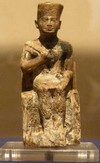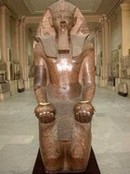Maps of the Antique
Mediterranean Sea
 The Egyptians The Egyptians
 Overview Overview
 Some dates Some dates
 Archaeological sites Archaeological sites
 Egyptian Art Egyptian Art
 World's museums World's museums
 Coinage Coinage
 Language and Writing Language and Writing

Photo credit:
 Alain Guilleux Alain Guilleux
Photos Egypte
All rights reserved.
|
EGYPT: SOME DATES
On our interactive map, we date the sites by mentioning the period and dynasties, which roughly locate the facts both in the time and in the cultural influence of the era. If you wish more details on the list of the Pharaohs of each dynasty, you may find them easily on the Web… though they often contradicteach other!
Indeed, the chronology of the History of Egypt is extremely problematic and remains discussed. In fact, the old Egyptians traditionally located the events according to the year of the reign of the ruling Pharaoh. But on one hand, the known lists of the kings are incomplete or imperfect, on the other hand, during the times of chaos (the "intermediary periods " in particular), several kings ruled at the same time in various parts of upper and lower Egypt so that the dynasties overlap, which makes interpretation difficult. At the later times, the dates could be corroborated by the accounts of foreign travellers (Greek in particular), but generally speaking, the dates that we give here are most of the time purely indicative.
The "Periods" mentioned below are generally admitted, though specialists sometimes disagree about the events which mark the beginning and the end of them... For example, some people place the 25th dynasty in the 3rd Intermediate Period, some in the Late Period. Some even include the Ptolemaic Period in the Late Period...
Predynastic Period: : 7000-3000 B.C.
The time of the settlement of Egypt, the emergence of kingdoms, the first necropoles. It may be divided in prehistory, period of Nagada I, Nagada II, and Nagada III (sometimes called “dynasty zero”).
Thinite (or early dynastic) period: dynasties 1 and 2 - 3000-2700 B.C.
A mythic king, Narmer or Menes, unified Egypt. The bases of the Pharaonic civilization were quickly put into place (principles, symbols, cults), and this for a very long time!
Old Kingdom: dynasties 4 to 6 - 2635-2150 B.C.

It was the time of the first great Pharaohs, the builders of the great pyramids. Some names: Djeser, Houni (3rd dynasty), Snefrou, Cheops, Khéphren, Mykerinos (4th dynasty), Ouserkaf (5th dynasty), Pepi II, Nitokris (6th dynasty).
A small statuette representing Cheops
© Alain Guilleux "Une promenade en Egypte"
First Intermediate period: dynasties VII to XI - 2150-2022 B.C.
The collapse of the kingdom left place to a period of chaos. Different dynasties followed or confronted each other in the area of Memphis. With the 9th dynasty (called dynasty of Antefs), rulers of Thebes succeeded in uniting Egypt. Some names: the Khety, Montouhotep Ier, the Antef.
Middle Kingdom: dynasties 11 and 12 – ca. 2030 to 1785 B.C.

When Montouhotep II reigned over a unified Egypt, began a time of great reforms, prosperity, exchanges with the neighbouring countries. Some names: Montuhotep, Amenemhat, Sesostris.
Sesostris I
© Alain Guilleux "Une promenade en Egypte"
Second Intermediate Period: dynasties 13 to 17 - 1785-1550 B.C.
Egypt broke up again in a multitude of small states, and the Hyksos invaded Lower Egypt, while the 17th dynasty ruled in Thebes. Its penultimate king, Khamose, wanted to unite the kingdom: his brother Ahmose achieved it.
New Kingdom: dynasties 18 to 20 - 1550-1069 B.C.
 Ahmose became king and founded the 18th dynasty. This was the glorious time of the New Kingdom, of the conquerors who imposed their presence in the Middle East and of the great builders. The 18th dynasty weakened during the reign of the “Heretic Pharaoh" Akhenaton (Amenophis IV, 1355-1338 B.C.), and ended with the death of his son Tutankhamun.
Ahmose became king and founded the 18th dynasty. This was the glorious time of the New Kingdom, of the conquerors who imposed their presence in the Middle East and of the great builders. The 18th dynasty weakened during the reign of the “Heretic Pharaoh" Akhenaton (Amenophis IV, 1355-1338 B.C.), and ended with the death of his son Tutankhamun.
General Horemheb restored the order. Ramses I succeeded him and founded the 19th dynasty. Ramses II raised the New Kingdom at the top of its splendour. However, with the last Ramses (20th dynasty), Egypt sank in insecurity, corruption and chaos. Some names: Amenhotep, Thutmosis, Hatchepsut, Akhenaton, Tutankhamun, Horemheb, Ramses, Sethi.
Hatchepsut - © Alain Guilleux "Une promenade en Egypte"
Third Intermediate Period: dynasties 21 to 24 - 1080-664 B.C.
Egypt was torn between the Libyan dynasties which ruled in the delta (dynasties of Tanis, Bubastis, of Sais) whereas Nubians exerted an increasing influence in Upper Egypt on the Theban priests who were ruling. Some names: Psusennes, Siamon, Sheshonq, Osorkon.
At the end of this period (that some class in the Late Period), Piankhy, a king of Napata (25th Nubian dynasty, that of the "Black Pharaohs "), conquered Upper Egypt and tried to take over the delta. The 24th ”Lybian” dynasty resisted. The Nubians triumphed for a while, but the Assyrians invaded the north.
Late Period: dynasties 26 to 30 - 667-332 B.C.
This was the beginning of a long period of instability and invasions which happened throughout the whole Late Period. In 667 B.C., king Assurbanipal lead a raid on all Egypt and imposed his authority on the small Egyptian kingdoms. He appointed the saïte king Nechao (26th dynasty). The 27th dynasty was Persian. Egypt recovered its independence for a short while, but in 343 B.C., the Persian king Artaxerxes III defeated Nectanebo II and founded the 31st dynasty, which was the last one. Some names: Nechao II, Cambysus II, Nectanebo, Artaxerxes III.
Hellenistic Egypt: Macedonian dynasty/Lagide Kings - 333-30 B.C.

Before turning towards the East, Alexander the Great conquered Egypt. At his death, his empire was shared between his generals, and Ptolemy received Egypt. The dynasty of the Ptolemies (or Lagides) associated not without success the Greek influence and the ancient Egyptian culture.
It ended when the Romans, worried by the dynastic quarrel in Egypt, landed in Egypt. After the departure of Julius Caesar, the dream of domination of Cleopatra VII ended when the Roman Marc-Antony who took up her cause, was defeated at the battle of Actium in 31 B.C.
Cleopatra and Cesarion - temple of Dendera
Roman Egypt: 30 B.C to 395 A.D.
After 30 B.C., Egypt became a Roman province, put under the authority of a "viceroy". It passed later under the rule of the Byzantine Empire...
|













 Alain Guilleux
Alain Guilleux 

 Ahmose became king and founded the 18th dynasty. This was the glorious time of the New Kingdom, of the conquerors who imposed their presence in the Middle East and of the great builders. The 18th dynasty weakened during the reign of the “Heretic Pharaoh" Akhenaton (Amenophis IV, 1355-1338 B.C.), and ended with the death of his son Tutankhamun.
Ahmose became king and founded the 18th dynasty. This was the glorious time of the New Kingdom, of the conquerors who imposed their presence in the Middle East and of the great builders. The 18th dynasty weakened during the reign of the “Heretic Pharaoh" Akhenaton (Amenophis IV, 1355-1338 B.C.), and ended with the death of his son Tutankhamun. 